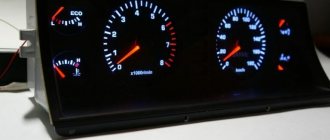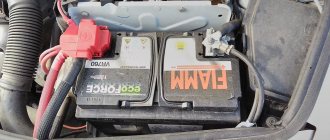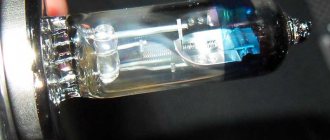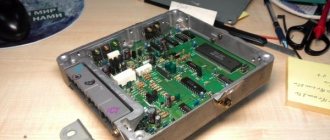The dashboard of a modern car is filled with all kinds of indicators and lights. Some of them are emergency, others are warning, others are simply service, and their operation should not cause any concern.
Among the lamps that are activated when the ignition is turned on is the battery indicator. If it doesn't light up, it's not a very good sign. There is a reason to conduct a diagnosis and determine why this is happening.
This is a typical situation that many motorists who own cars of different brands, models and ages have encountered.
The charging lamp does not light up.
If the charging lamp does not light, but other devices are working, then it may have burned out, there is a break in the excitation wire to the generator, or the generator is faulty. If all the panel devices do not work, then you should start by checking the fuse. When a lamp burns out, the generator is excited through an additional resistance, so the integrity of the lamp does not affect the operation of the charging circuit. The only exception was the first cars of the VAZ 2110 family, but this drawback was quickly eliminated, and not many such cars were produced.
A light bulb may burn out due to a faulty electrical circuit.
A problem with the circuit that powers the battery light can be caused by several things. Let's consider everything.
So, problems with contacts are becoming quite common. Usually this situation occurs in the spring, after cold weather. During the winter months, moisture accumulates on the connectors, causing the formation of oxides. This makes the contact much worse, as a result of which the indicator stops turning on.
Electrical circuit diagram of VAZ 2107
As a rule, this problem does not appear immediately and is not stable. In other words, the light bulb may light up one time and not another time. The solution to this problem is to clean all connectors. They should be treated with a grease specifically designed for this purpose.
The light bulb may burn out due to an open circuit. To make sure of this, you should arm yourself with a multimeter. The device checks the circuit to determine the faulty section.
Checking the generator.
To check the functionality of the generator and the charge of the battery, you need a multimeter. An inexpensive electronic device such as DT830C, M833, APPA iMeter 3 or similar is best suited for this. Pointer multimeters require precise polarity when connecting, and are very sensitive to shocks and falls. To check, just measure the voltage at the battery terminals. If the voltage is within 13.5 - 14.5 V, then the generator is working. If the voltage is less than 13.5 V, then the generator is faulty and the cause must be found and eliminated.
FakeHeader
Comments 15
I have the same bullshit with the business tidy, and when I set it to business, there is no charging when it’s cold until you rev it up to 1200, but when it’s hot it immediately appears. I put the tidy up to my business, there is no such problem... Even if it’s hot or cold, the charge goes straight away.
The generator is excited through the lamp. Look at the wiring (lamp circuit) from the dash to the generator. There is a break/poor contact somewhere. There may be a malfunction in the transition connector from the passenger compartment to the engine compartment; this is a common problem with them.
Can you tell me where this adapter connector is?
Connection of underhood and interior wiring. I came across a gazelle with connectors directly on the engine shield (round).
In the fall I installed new ones with a 3-level regulator
I see the tidy is old and I’m talking about business, sorry, I didn’t understand. Clean out all the masses, pluses, everything up to the genes and before in the box near the battery.
Sorry guys, I don’t have a bulletin board for this, but the problem is tidying up the gazelle business. There you need to solder the resistance and everything will be good. This problem is written down on the drive + photos where to show it.
So I don’t have a business, I’m just a non-entity
Sorry guys, I don’t have a bulletin board for this, but the problem is tidying up the gazelle business. There you need to solder the resistance and everything will be good. This problem is written down on the drive + photos where to show it.
And I’m looking))) Resistance is quite possible. But, I have voltage at the excitation terminal, 11.5 volts.
The charging lamp does not light up, search for reasons.
What should you do if the charging lamp does not light up when you turn on the ignition? How to quickly find a problem? All subsequent actions regarding the warning lamp do not apply to the VAZ 2101 (2103, 2106).
The first step is to determine the faulty location, that is, the generator or control lamp with wire is faulty. To quickly determine, you need to disconnect the thin wire from the generator that comes from the control lamp, connect it to the vehicle ground and turn on the ignition. If the lamp lights up, then the generator is faulty. Possible malfunctions may be a break in the generator winding, a malfunction of the voltage regulator, wear of the armature brushes or slip rings, and so on.
Checking the serviceability of the lamp and wire.
If the charge control lamp does not light up, you need to check the serviceability of the lamp and wire. For this check, you do not need to remove the instrument panel and pull out the lamp to examine the integrity of the filament. It is enough to connect one probe of the multimeter, in voltmeter mode, to the disconnected wire, and the second to the car body. Instead of a multimeter, you can use a test lamp with a power of no more than 1 W.
If the circuit is working properly, the multimeter will show the battery voltage, and the control lamp will glow at half-glow. In this case, the charge control lamp burned out. If the voltmeter reading differs greatly from the battery voltage, then there may be an open circuit in the circuit from the control lamp to the generator.
How to determine a breakdown
If the battery light comes on and does not turn off when the engine is running, the first thing to do is check the charging. The electrodes of the multimeter are applied to the terminals freed from wires. On a correctly functioning and charged battery, the device shows a voltage of 12.2-12.5 V. If the reading is below 12 V, the battery needs additional charging with a charger. The next step should be diagnosing the generator. To do this, connect wires to the terminals and, with the motor running, measure the voltage on them with a multimeter. At idle speed and with consumers turned off, the device should show 13-14 V. As the engine speed increases to 3000 per minute, the voltage will increase to 14.4-14.5 V. Then, without reducing the speed, turn on electrical appliances, increasing the load. The indicator should not fall below 13 V. If the voltage does not meet the standards or is absent, the generator is faulty.
You can check the serviceability of the generator the old fashioned way. With the engine running, disconnect the wire from the positive terminal of the battery. If the engine stalls, the generator is faulty.
Important! This diagnosis must be carried out while wearing dielectric gloves. Although the voltage is low, the currents are high and can harm the body
The brightness of the dashboard illumination and optics changing with the number of revolutions indicates problems in the operation of the generator or weakening of the drive belt tension. You can test the voltage relay by directly applying voltage from the battery to its contacts. If the indicator on the generator brushes is 12 V, the relay is working properly. If the indicator does not meet the standard, the device is replaced with a new one.
Let's consider options for other breakdowns, methods for diagnosing and repairing them.
1. Symptoms: the voltmeter on the instrument panel shows a charge, the battery charging lamp does not turn on, the voltage at the battery terminals is about 12 V, the power source itself is completely discharged. First, clean the terminals on the battery. If the situation has not changed, then measure the voltage at the generator. Why is one electrode of the multimeter pressed to terminal “30”, the second - to ground. In cases where the voltage exceeds the value on the battery, then terminal “30” is carefully cleaned with sandpaper. In addition, carefully inspect the wire from the generator to the battery for insulation integrity and breakage. If necessary, it is replaced with a new one.
2. Symptoms: the on-board voltmeter and warning light show charging, the voltage at the battery terminals is about 14 V, the battery itself is discharged, when the load increases (signal, headlights on), the voltmeter needle drops to a minimum. A common cause is loose tension, wear or breakage of the alternator belt. The sagging belt is tightened so that when pressed by hand it bends by 1-1.5 cm, the worn one is replaced with a new one. If one of the pulleys wears out, manipulating the belt will not give a positive result; you must contact a specialist. Another reason could be a breakdown of one of the generator diodes. The engine is turned off and the diode bridge is tested completely with a multimeter. Faulty diodes are replaced. The generator brushes are also checked. If the length is less than 5 mm, they are replaced
Also pay attention to the cleanliness of the brush holders. Dirt trapped in them causes the brushes to become stuck.
The wear of the commutator slip rings is eliminated by service station specialists.
3. Symptoms: when you turn the key in the ignition switch, the battery light does not light up, the on-board voltmeter needle does not move, the battery does not charge. The first reason may be a blown charging circuit fuse. If after replacing it the situation has not changed, then the breakdown should be looked for in the relay or ignition switch.
4. Symptoms: when the ignition is on, all devices work, the charging indicator does not light, there is no charging. Initially, remove the wire from terminal “61” on the generator and connect it to the negative (body). If the battery light comes on, the rotor winding is shorted or broken. The same symptoms are produced by a loose contact in the connector. In this case, all indicators may light dimly, intermittently, or not light up at all. When the contacts are processed with sandpaper and only the battery light does not light up, it means it is burnt out and requires replacement.
5. Symptoms: when you turn the ignition key, the lamp lights up, after starting the engine it does not stop burning, battery charging is intermittent or absent. The reason may be due to a weak wire connection and connector on the instrument panel. The contact is cleaned with sandpaper.
Burnt out battery indicator light
A fairly common cause of this problem is lamp failure. This is perhaps one of the simplest breakdowns, but it is not always harmless. It is advisable to replace the light bulb as quickly as possible. If there are problems with it, you will not be able to identify the problem with the generator in a timely manner. Which will lead to the battery being discharged at the most inopportune time. Thus, driving with a burnt-out lamp is highly not recommended.
Battery charge indicator light VAZ
You should also consider the design features of your car. Most generators have a built-in resistance. This allows you to generate energy even when the charge control lamp is burnt out. On some cars, the lamp itself plays the role of resistance.
This can be found on some modifications of the VAZ 2112, as well as many old foreign cars. In this case, when the light bulb burns out, the generator stops producing current. If your car has this structure, you should always have a spare lamp.
A light bulb may burn out due to a faulty electrical circuit.
A problem with the circuit that powers the battery light can be caused by several things. Let's consider everything.
So, problems with contacts are becoming quite common. Usually this situation occurs in the spring, after cold weather. During the winter months, moisture accumulates on the connectors, causing the formation of oxides. This makes the contact much worse, as a result of which the indicator stops turning on.
Electrical circuit diagram of VAZ 2107
As a rule, this problem does not appear immediately and is not stable. In other words, the light bulb may light up one time and not another time. The solution to this problem is to clean all connectors. They should be treated with a grease specifically designed for this purpose.
The light bulb may burn out due to an open circuit. To make sure of this, you should arm yourself with a multimeter. The device checks the circuit to determine the faulty section.
Low battery
Another common reason why the battery warning light does not light up when the ignition is turned on in a VAZ 2106 - 2107 is a weak battery.
If, at the same time that the battery light does not light up, the dashboard instruments do not turn on or are dimly lit, then this is a clear sign of a low battery. The problem can be “cured” by simply charging the battery.
Good battery
However, not all so simple. The discharge of a car battery may not occur because the owner did not have time to charge it in time or forgot to turn off the headlights. A problem with a battery becomes dangerous if the cause lies in the generating device. As you know, the battery must be charged while the car is moving, otherwise it will discharge quite quickly. And this function falls on the generator. But if the latter is faulty, then problems arise.
Theory “on fingers”: how everything works
On the VAZ 2107, devices can receive power from 2 sources. The first is the battery, the second is the generator. The battery supplies energy when the engine is turned off. It has a certain charge, consumed as needed. The generator produces electricity, but only if the rotor is spinning. That is, with the engine running.
Battery operation diagram: 1. Battery, 2. Negative diode, 3. Additional diode, 4. Generator, 5. Positive diode, 6. Stator winding, 7. Regulator, 8. Rotor winding, 9. Capacitor, 10. Mounting block, 11. Control lamp, 12. Voltmeter, 13. Ignition relay, 14. Lock.
The battery charge is used to start the engine. When the engine starts running, the battery energy is not consumed: the generator supplies all devices with it. A charge is also supplied to it to restore wasted energy. But if the battery is not charging, its own energy will be enough for a limited number of starts. The battery will then be completely discharged. And the car owner will have to solve the problem of how to start a VAZ 2107 if the battery is dead. After all, not everyone has “crocodiles” in their trunk, and not everyone will agree to share electricity with their battery.
Useful tips
To prevent your car from having problems charging the battery, use the following tips:
Don't ignore your car's dashboard signals. In this case, you will be able to solve the problem at the initial stage of its development. Inspect the alternator belt regularly. The correct operation of all electrical equipment on board directly depends on it. If there are any defects, replace it as soon as possible. Check the voltage from the generator to the battery
If you notice a discrepancy, diagnose the on-board network. Periodically pay attention to the condition of the battery terminals. If you notice oxidation, eliminate this defect
They can be treated with WD-40. Isolate the generator and battery from water to prevent short circuits. Leave engine washing to professionals. When repairing the battery charging circuit, do not use cheap spare parts.
To summarize, we note that the battery is the most important element in the car’s electrical network. Therefore, you should carry out timely maintenance of the charging circuit and, if necessary, change the necessary parts. In this case, you will ensure a proper system of work. In the article, we told you about the main malfunctions that can cause the battery charging lamp to light up and what to do about it. We hope our recommendations will help you in solving the problem at hand.
Color designations
There is no uniform standard for color coding; green and red provide more or less significant information.
Black
In many cases this means low electrolyte levels and the battery must be removed and sent to a battery technician.
White
About the same as black, much depends on the specific design of the indicator. Don’t worry, in any case, the battery requires further investigation.
Red
Makes more sense now. Ideally, this color means reduced electrolyte density. But in no way should you call for adding acid; first of all, you should evaluate the degree of charge and bring it to normal.
Green
It means that everything is in order with the battery, the electrolyte is normal, the battery is charged and ready for use. Which is far from a fact for the reasons stated above.
Fuse
A failed dashboard light may be caused by a blown fuse. In this case, several devices usually fail at once. If such a symptom appears, you just need to check the fuse. It is located in the mounting block. You can find it using the diagram on the block cover. To check, the fuse is removed from the mounting block.
The easiest way is to install a known good fuse. If this is the reason, then the light should light up when the ignition is turned on. You can also check the fuse by measuring the resistance with a multimeter.
Solutions to the problem
| Reason for violation | Remedy |
| Discharged battery | Charge the battery |
| Blown fuse | Replacing an element |
| Oxidation of battery terminals | Cleaning the contacts with fine-grained sandpaper and treating with an anti-corrosion compound |
| Power cable insulation failure | Replacing the wire from the battery to the generator |
| Broken wiring in a section of the circuit | Repair the break, or replace the wire on the segment with a new one |
| Faulty contacts at the ignition coil terminals, fuse mounting in the socket, rotor leads, or indicator light | Secure the terminals, having previously cleaned them of oxides. |
| Worn mounting block relay | Relay replacement |
| Diode bridge failure | Replacing one of the diodes or the entire block |
| Failure of the generator voltage regulator relay | Relay replacement |
| ECU error | Reset the error (reboot the system by turning the ignition on and off for at least 15 seconds) |











